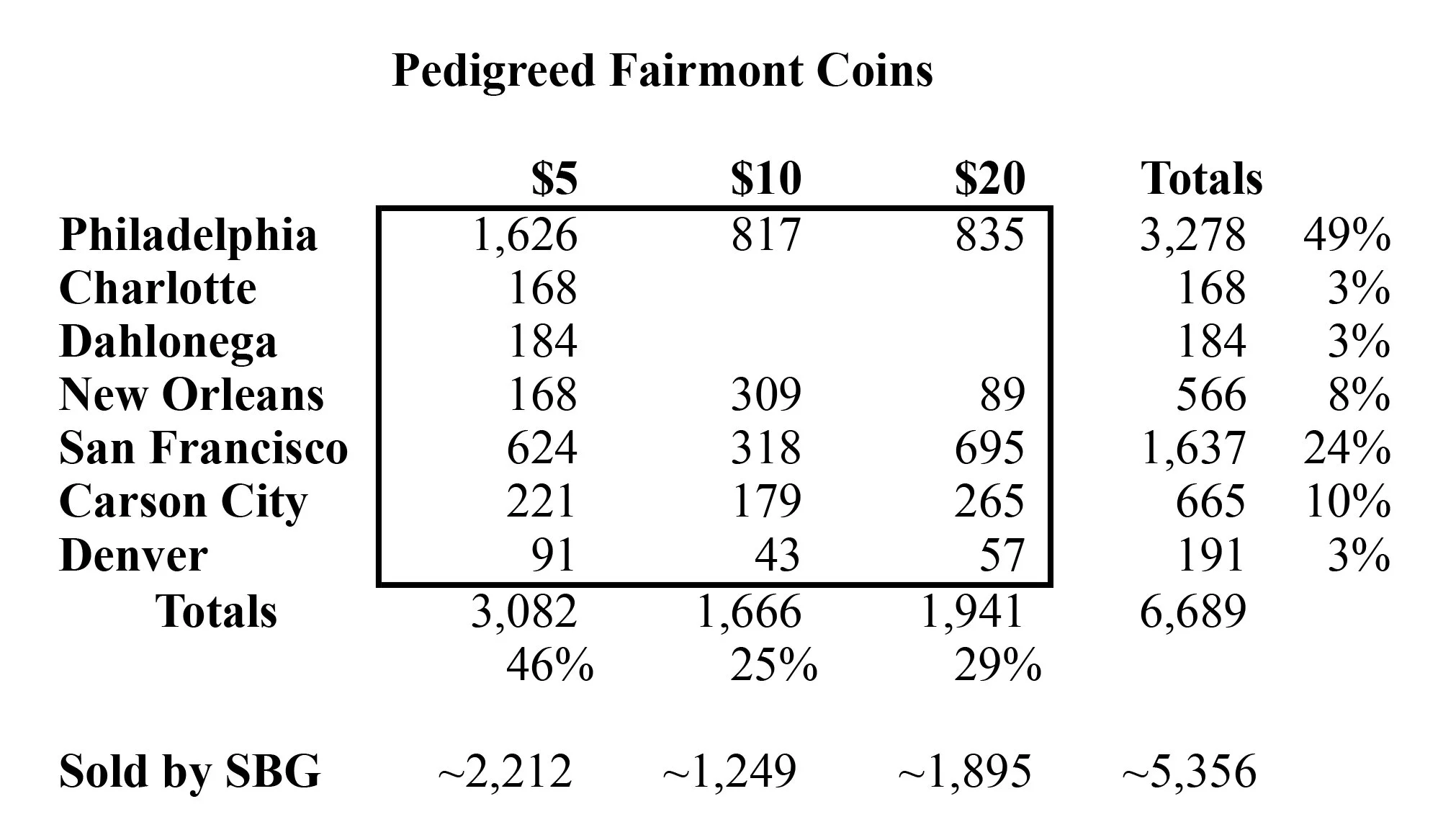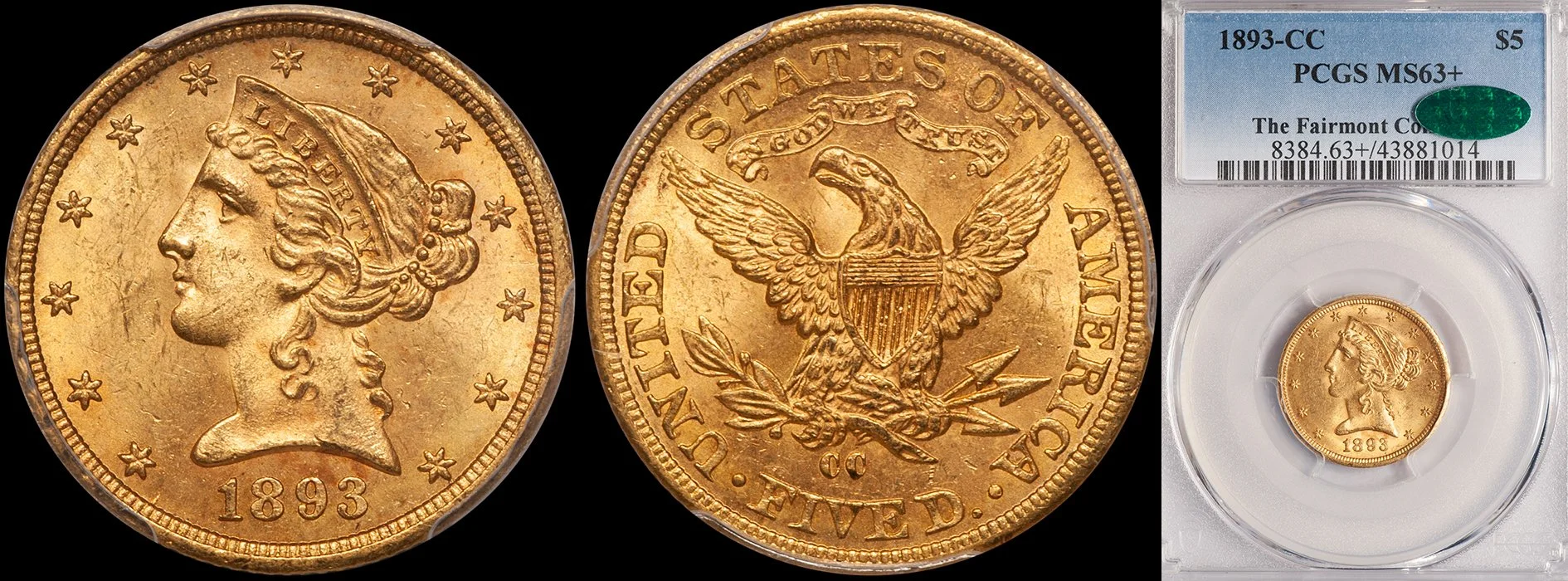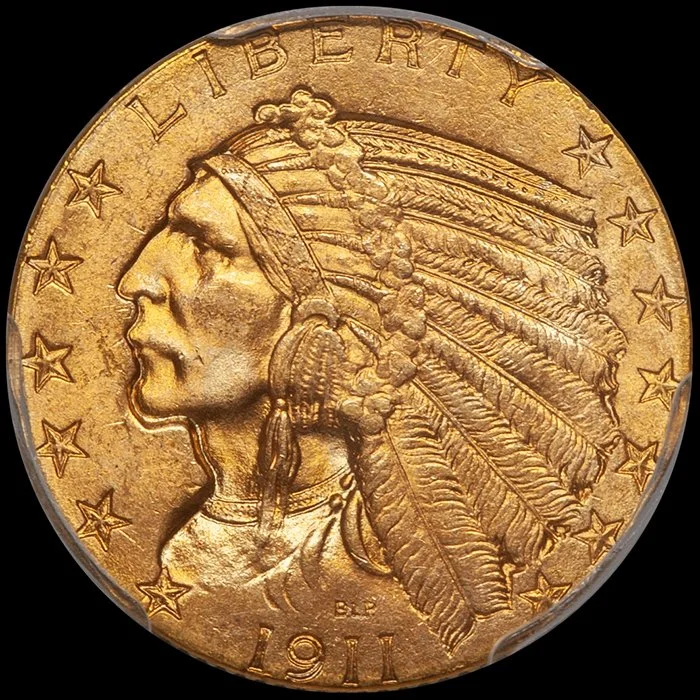Fairmont Gold Pieces, Part I: The Pedigreed Fairmonts
/Introduction
Hello. My name is Richard Radick, and I am writing as a guest blogger on Doug’s site. Those of you who have read the recently-published fourth edition of his book “Gold Coins of the Dahlonega Mint” already know a bit about me, because I wrote an introductory chapter for that book. For those of you who have not yet read Doug’s book, it’s time to buy a copy - it’s a remarkable work of numismatic scholarship. (Full disclosure - I have no financial stake in the book sales, and I bought my copy just like everyone else).
I first became aware of the Fairmont Collection in 2020, when I happened to read a couple of Doug’s articles on the subject, in particular “One of the Coolest Hoards of US Gold Coins Ever Seen Has Entered the Market, and You (Probably) Don't Even Know About It...” (May, 2019) - I was one of those ignorant people - and “What I Learned About Liberty Head Half Eagles from the Fairmont Hoard” (August, 2020).
Before then, my primary numismatic interest for many years had been National Bank currency. Unlike coins, bank notes have serial numbers, so it’s possible to make comprehensive lists of known examples. In fact, there are people who have invested enormous effort over several decades doing just that: John Hickman, Don Kelly, and Peter Huntoon, in particular, deserve mention, and there is even a National Currency Foundation that maintains a website devoted to this corner of numismatic esoterica. I joined in that activity, with advice and encouragement, first from Don, and then Peter.
Given this background, it is perhaps not too surprising that I decided to apply the experience and techniques I developed over some two decades studying Nationals to the question of determining the size and makeup of the Fairmont Collection. It’s been clear for some time that Stack’s Bowers is not likely to supply this information anytime soon (if ever), but I also felt that it should be possible to collect and analyze enough data to make a reasonable stab at the answers.
And so it began.
1860-C $5.00 PCGS AU58 CAC, ex Fairmont
In late 2020, I started corresponding with Doug about this. It quickly became apparent that several things simply didn’t add up, for example: “Where were the higher-grade Dahlonega and Charlotte half eagles that should be in the Fairmont Collection?” and “Why did the scarcer $10 Liberties seem to be so badly under-represented?”
In April, 2022, we got some of the answers, when the Hendricks Set crossed the Stack’s Bowers auction block.
In retrospect, the Fairmont sales have been marked by three seismic events: (1) The first Fairmont sale in June, 2018 (double eagles, only); (2) the August 2020 sale (the first half eagles); and (3) the April, 2022, Hendricks Set sale, with its numerous high-condition rarities, followed by five more “named” sets - more on those six named sets, below. Given the two-year cadence, I can’t help but wonder if we may be due for our next surprise sometime in 2024.
In the remainder of this piece, I will introduce some nomenclature - actually, I already did so, in the title, and some readers may still be wondering: “What’s a pedigreed Fairmont?” - and conclude with a quantitative discussion of the basic demographics of these coins.
For those of you who are considering adding Fairmont pieces to your collection, I highly recommend taking a look at Doug’s inventory as a starting point. Unlike many offerings out there, the current DWN Faimont Inventory is both accessible and highly curated for quality and lasting value.
Nomenclature
As of late 2023, the Fairmont Collection comprises almost 6,700 US gold coins, graded by the Professional Coin Grading Service (PCGS) and carrying “The Fairmont Collection” pedigree on their holders. These coins have been marketed by Stack’s Bowers Galleries (SBG) in an ongoing series of auctions that began in June, 2018.
Despite the word “collection,” the Fairmont Collection is not a purpose-built collection in the usual sense of the term – rather, it is part of a hoard. It is now quite evident that the Fairmont Collection, as defined above, is only a small part of a much larger parent population, encompassing the best coins from this hoard in terms of both rarity and condition. Unlike many US gold coin hoards recovered from foreign banks or shipwrecks, the Fairmont hoard is not limited to a few date/mint varieties. Its oldest coins were minted in 1834 (Classic Head $5s), the newest in 1932 ($10 Indians), and everything in between is present proportionately, lacking only some of the rarest issues. In other words, the Fairmont hoard evidently samples the population of gold coins that was present in the United States in the early 1930s, prior to the gold recall order of 1933.
Due to its sequential marketing and the secrecy shrouding its source and content, our knowledge of the Fairmont Collection continues to evolve as its serial sale continues. Almost all of its known coins are half eagles, eagles, or double eagles; there is a single stray $3 coin, and one $5 Territorial. To date, no gold dollars or quarter eagles have appeared, and it is beginning to look like none ever will.
Conceptually, the parent population of the Fairmont Collection may be divided into three components:
(1) The nearly 6,700 coins of the Fairmont Collection itself, graded by PCGS and carrying “The Fairmont Collection” pedigree on their holders. These are what I designate the “pedigreed Fairmont coins”;
(2) Some 350,000-400,000 coins that have been graded by PCGS, starting in 2018 and continuing up to the present time, that do not carry the Fairmont pedigree on their holders. These tend to be common-date coins of somewhat lesser condition than the pedigreed Fairmont coins. There are several fairly convincing (convincing to me, at least) reasons to believe these coins are from the Fairmont hoard. I discussed some of these in my introductory chapter to Doug’s book, and I will not repeat that discussion here. In one respect, however, it doesn’t actually matter much whether these coins are from the Fairmont hoard or not - they indisputably exist, and they will enter the marketplace, sooner or later. Some already have. I call these the “non-pedigreed Fairmont coins,” and I will describe them at length in a forthcoming piece; and
(3) Coins from the hoard that have either not been submitted to PCGS for grading, yet, or have not been deemed worth the time and expense of grading. I call these the “ungraded Fairmont coins,” and I tentatively plan to discuss them, also, in another forthcoming piece.
By searching SBG’s auction records, analyzing PCGS certification and population report data, and monitoring selected dealer inventories, it has been possible to build a database for the pedigreed Fairmont coins, as defined above, that seems likely to be more-or-less complete, and also to develop considerable insight into the population of non-pedigreed Fairmont coins. Again, I have discussed this methodology at some length in the book chapter, and I will not repeat it here. In contrast, information about the ungraded Fairmont coins remains sketchy, and probably always will.
Demographics of the Pedigreed Fairmont Coins
The table below summarizes the makeup of the known population of pedigreed Fairmont coins, as defined above, by denomination and mint. These numbers are current, and include the coins in SBG’s November, 2023, sale of the Kronen Set. They do not, however, include the single $3 or the $5 Territorial (both in the Hendricks Set).
One striking thing about these numbers is how many of the pedigreed Fairmont coins are half eagles (almost half), and how many are from Philadelphia (again, almost half). Indeed, over 24% of the total number of presently-known pedigreed Fairmonts are Philadelphia half eagles. On the other hand, only rather small slices are from Charlotte and Dahlonega (or, for that matter, Denver). Over half of the pedigreed Fairmonts from New Orleans are eagles, split fairly evenly between the two Liberty Head varieties (more on this in Doug’s forthcoming book). Carson City coins are quite well represented, at 10% of the total.
At the foot of the table is my best estimate for how many of these pedigreed Fairmonts have been sold by SBG through November, 2023. The numbers are probably a bit low, because they come from auction records. SBG occasionally sells pedigreed Fairmont coins outside their auctions: for example, some have appeared in Doug’s inventory, and JM Bullion has recently also started offering a few. There also have probably been some private sales.
Overall, some 80% of the pedigreed Fairmonts have been sold by SBG at auction.
The remaining 20% are not, however, evenly distributed across the three denominations. Relatively few double eagles remain in inventory. For the half eagles and the eagles, significant fractions of the unsold coins are two batches, graded about five years ago: 300 1901 $5s and 300 1901 $10s, almost all graded MS-63. A few of these 600 coins have entered the marketplace, but I think most of them have not. Net these coins, I estimate the unsold inventory of pedigreed Fairmont coins to number about 500 half eagles, 100 eagles, and 50 double eagles. Some of these coins will undoubtedly appear in future SBG auctions.
More importantly, however, the number of pedigreed Fairmont coins may continue to grow. Every one of the six named-set auctions that have occurred so far, starting with the Hendricks Set in April, 2022, has been preceded by about ten weeks by a batch of 300-400 pedigreed Fairmonts receiving their grades from PCGS, and I have become fairly quick to notice when this happens. If there are to be future named-set Fairmont auctions, the next one may very well be part of SBG’s Spring Auction in March, 2024, and I expect to know several weeks in advance that it is coming.
The following table presents some data for the six named-set sales of pedigreed Fairmont coins that have occurred to date. For each denomination, the total number of coins and the percentage that carried CAC stickers are tabulated for each sale, along with some totals.
It is now very clear that these six sales represent the best of the pedigreed Fairmont coins, in terms of both rarity and condition. Some progressions in number and quality (as measured by the CAC numbers) are also evident in the sequence of sales, although the CAG Set broke the trends to some degree in both respects: it was smallest of the six, but high quality, especially among its $10s and $20s.
Curiously, two half eagles in the CBL sale were non-pedigreed Fairmonts, per their holders, even though they were catalogued as pedigreed Fairmonts. Errors happen.
Coming soon - a detailed discussion of the non-pedigreed Fairmont coins…













